Stages SB20 exercise bike: a bulletproof home trainer?
A robust indoor training bike with tons of adjustability and a very heavy flywheel

An extremely robust indoor bike option, which offers ample adjustability (perfect for a pregnant tester, right up to 38 weeks). Over nine months of testing, we experienced only one instance of power irregularity - which was fixed in minutes. The ERG mode could be a bit sharper, but if you're after day-to-day reliability and a bike you can churn away on daily, the Stages SB20 comes highly recommended.
-
+
Very customisable shifters
-
+
High level of adjustability
-
+
L/R power measurement
-
+
Extremely durable
-
-
No feedback on the unit to show gearing
-
-
ERG mode seemed a little slow to react
You can trust Cycling Weekly.

The volume of choice available for a cyclist seeking a dedicated bike for their indoor cycling has increased rapidly in recent years. Competitors to the Stages SB20 include Wahoo's Kickr bike, the Wattbike Atom, and the Tacx Neo bike. All options represent a hefty investment, and - to be honest - come with fairly similar 'on paper' spec sheets, leaving reviewers splitting hairs over which can take home the title of the best indoor exercise bike for cyclists.
Stages' unique selling point over the competition, it says, is its durability. The brand is responsible for manufacturing a high volume of the machines you'll see in commercial gyms, which means it needs to create hardware that can withstand vigorous use and - in many cases - fairly lackluster maintenance.
Having used the Stages SB20 as my sole indoor trainer for nine months, I can vouch for this claim; I've yet to see any sign of wear or symptoms of the ultimate home trainer killer: sweat ingress.
Stages SB20: construction
There's no two-ways about it, Stages' SB20 is a heavy weight. It comes in at 62.5kg, 23kg of that in the flywheel.
The gross weight of a packaged bike is 72.5kg. In the UK, distributor Saddleback offers the bike with a "white glove" service (for an extra £200), which means consumers can expect it to be delivered and set up in their house. I had no such assistance - and that is 80% of the reason that the bike has spent its residence in my home living downstairs. Unlike the Wahoo Kickr bike, which I did transport upstairs, the weight was very heavily distributed at the flywheel, making the process more difficult. It would absolutely be possible to get it upstairs was that to be its 'final resting position', but for a test loan, it didn't feel worth it.
Assembly is really very simple and involves a few turns of some Allen keys. The front of the bike sits on wheels, meaning it's actually very easy to move around the home, provided you're staying on one floor and don't need to maneuver over any ledges or uneven surfaces. I managed it with ease whilst 30 weeks pregnant, so make of that what you will.
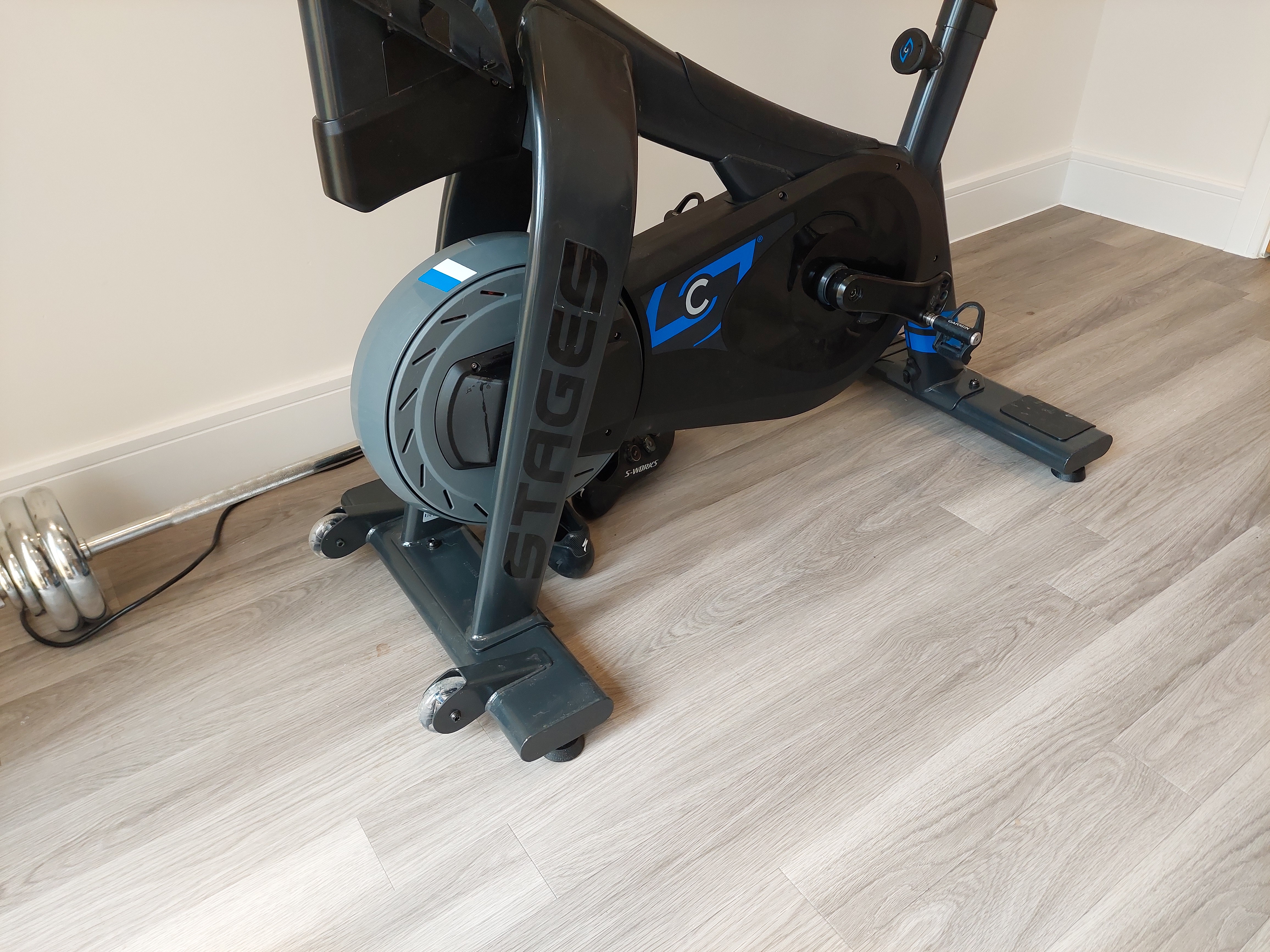
All of the wires are well hidden, with a 'nose cone' at the front of the bike hiding some key connections, and ensuring that sweat stays out.
Like the majority of competitors at this price point, Stages has opted for electromagnetic resistance. This is the premium choice and offers the most life-like and smoothest pedal feel. However, at this price, it's in line with the competition and you'd expect nothing less. The flywheel is driven by a Gates carbon belt, which is extremely quiet, you couldn't hear the bike whirring from adjacent rooms in the house.
Stages claim that the bike can take a maximum of 3,000watts - which is more than most of us could dream of producing, and it will mimic climbs up to 25%.
Power measurement comes from two Stages cranks. This means that, unlike bikes which determine power output via an algorithm based on cadence and resistance, this machine is able to provide left/right readings. This is a feature I use outside, when riding with Favero Power Meter pedals, and I do find it useful for predicting when a reoccurring back injury is about to rear its head (usually, I'm at ~51/49%, if this drifts closer to 53/47%, I know I need a rest and some stretching). Interestingly, the L/R balance from Stages sessions did not display on my TrainingPeaks files - but the data was all there in the app.
It won't take the most observant of readers to notice that the Stages SB20's climed power accuracy is sub-par when compared with other models at this price point: +/-1.5% is a 0.5% greater drift than you'd expect for a bike of this nature. However, scroll down to 'the ride', and you'll see that the actual data proved to be in-line with the Garmin Rally pedals, which claim +/-1%, so I've got no real concerns here.
The shifters sit aboard a standard handlebar, and it's possible to swap this for your own if you'd like to change the width (the saddle can also be swapped).
There's a wealth of customsiation available at the shifters, with set up taking place within the Stages app. You can set the bike up to mirror a Shimano or Campagnolo system, it can be 1x, or 2x, or you can opt for a "dream bike" setup, where you can choose the number of gears you want as well as the increments between them.
Personally, I went for Shimano, 52/36, 11speed with an 11-28 - call me uninspiring if you like (boring, even), but I appreciate familiarity.
There are shift buttons on the inside of the shifters, and also on the drops. Stages has also provided auxiliary ports, so it would be possible to add TT extensions, should you wish to mirror a time trial racing setup.
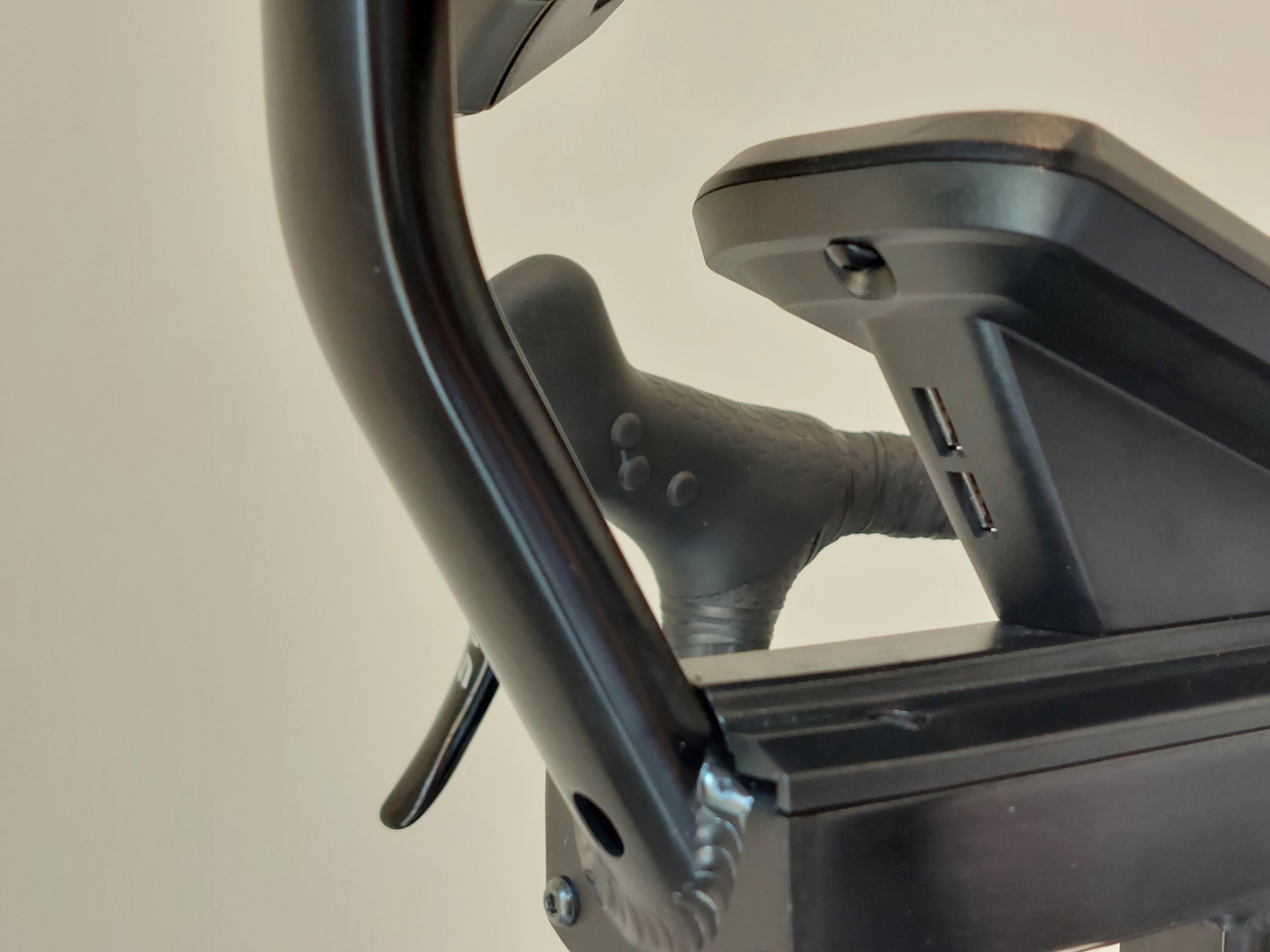
The brakes are functional, though at present within Zwift, pulling them on just forces you to pedal harder; steering is also readily provided, again, only to be functional once software platforms such as Zwift roll out compatibility. But at least the bike itself should be futureproofed for these expected tech arrivals.
On a less positive note, there's no display to show what gear you're actually in, at all. In reality, you'll be able to feel increases or decreases in resistance as you pedal and change gear, but if I were in a competitive environment (eg, a Zwift race), personally I'd like to be able to look down and clock if I was in the 52/11.
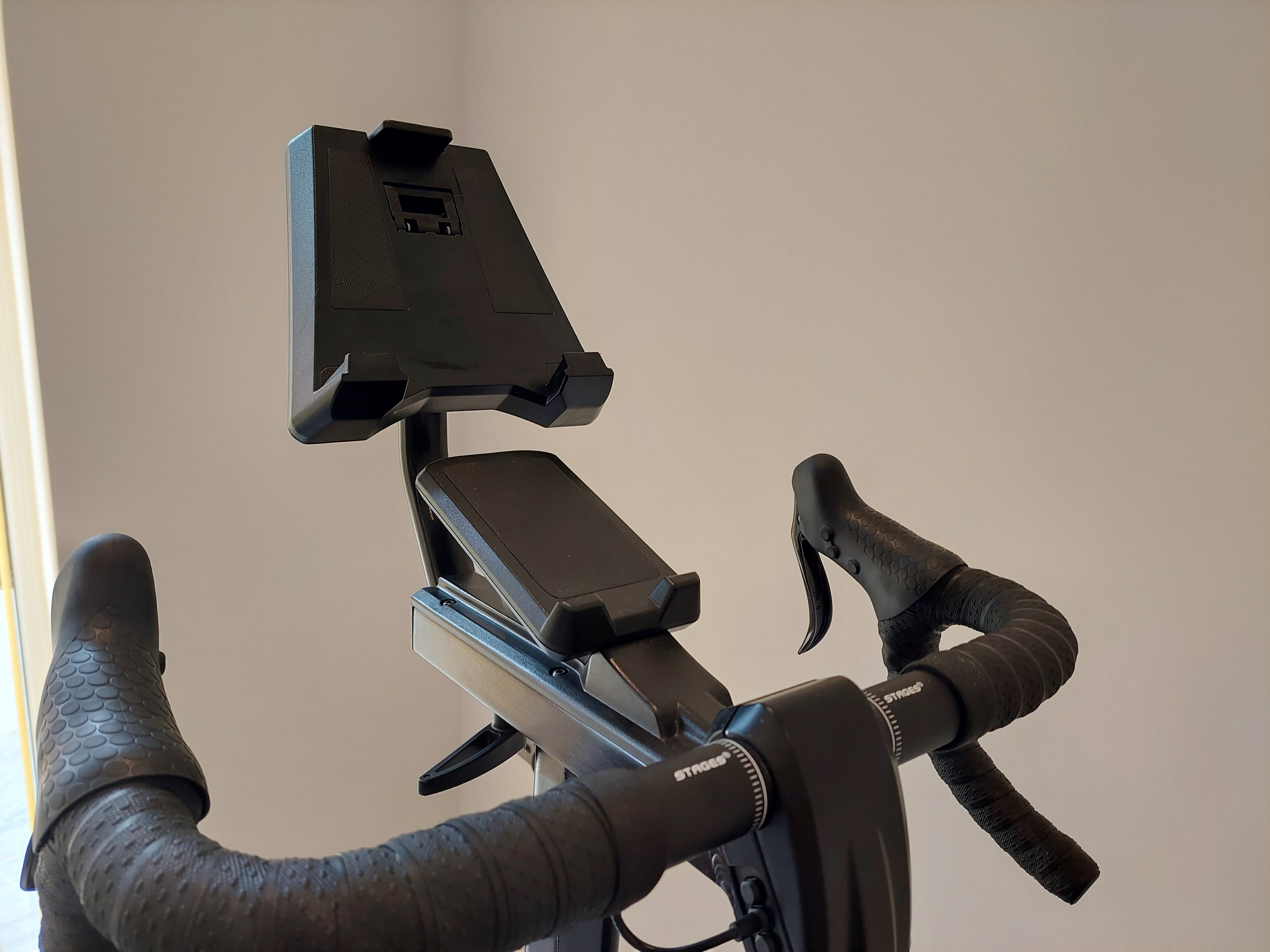
Stages do win points for their 'user console', as I'll call it. Not only does the bike come with a very solid tablet stand (which has a smaller clasp within it, to hold a phone if you're using that as your main device), it also has a space to place your phone/a remote/other, plus bottle cages and two USB ports, so you're sorted if you log on for a session only to realise you've got 5% iPad battery remaining.
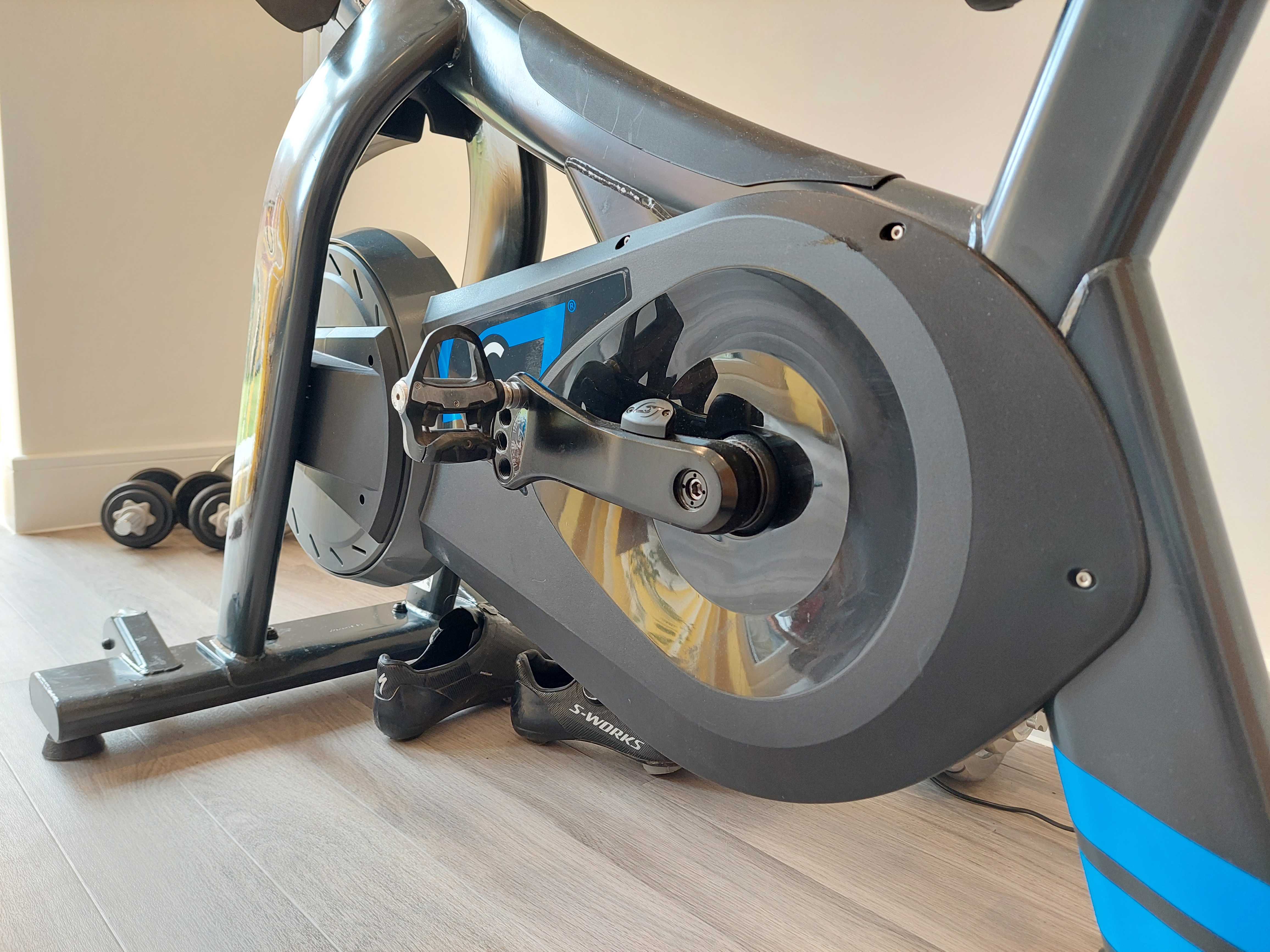
Another major selling point for exercise bikes of this nature is their adjustability, and Stages' offering is no different. Stages says the bike will suit riders from "XS to XL", this is gloriously vague. However, the saddle height, reach, handlebar height and fore/aft are all adjusted via knobs and levers and leave vast amounts of space for movement. The min saddle height is 52cm, with the max at 85.5cm, whilst the reach is 40cm to 55cm and the stack 54.5cm to 76cm.
The cranks can be set up to mimic a 165mm, 170mm, 172.5mm or 175mm set up.
Connectivity is via Bluetooth and Ant+, and, as you'd expect, the bike is compatible with indoor training apps such as Zwift, Peloton, TrainerRoad, Wahoo X, and so on.
| Row 0 - Cell 0 | Stages SB20 | Wahoo Kickr Bike | Wattbike Atom Gen 2 | Tacx Neo bike |
| Power accuracy | +/- 1.5%, dual sided | +/- 1% | +/- 1% | less than 1% |
| Weight | 62.5kg | 42kg | 45kg | 50kg |
| Flywheel | 23kg | 13lbs | 9.3kg | Unlisted |
| Resistance unit | Electromagnetic, Gates carbon belt drive | Electromagnetic, "enhanced motor" | Electromagnetic | Electromagnetic |
| Peak power | 3000w | 2200w | 2500w | 2200w |
| Graident simulation | + 25% | + 20% to -15% | 25% | 25% |
| RRP | £2800/$3149 | £3299/$3800 | £1999/$2400 | £2299.99/$3200 |
Stages SB20: the ride
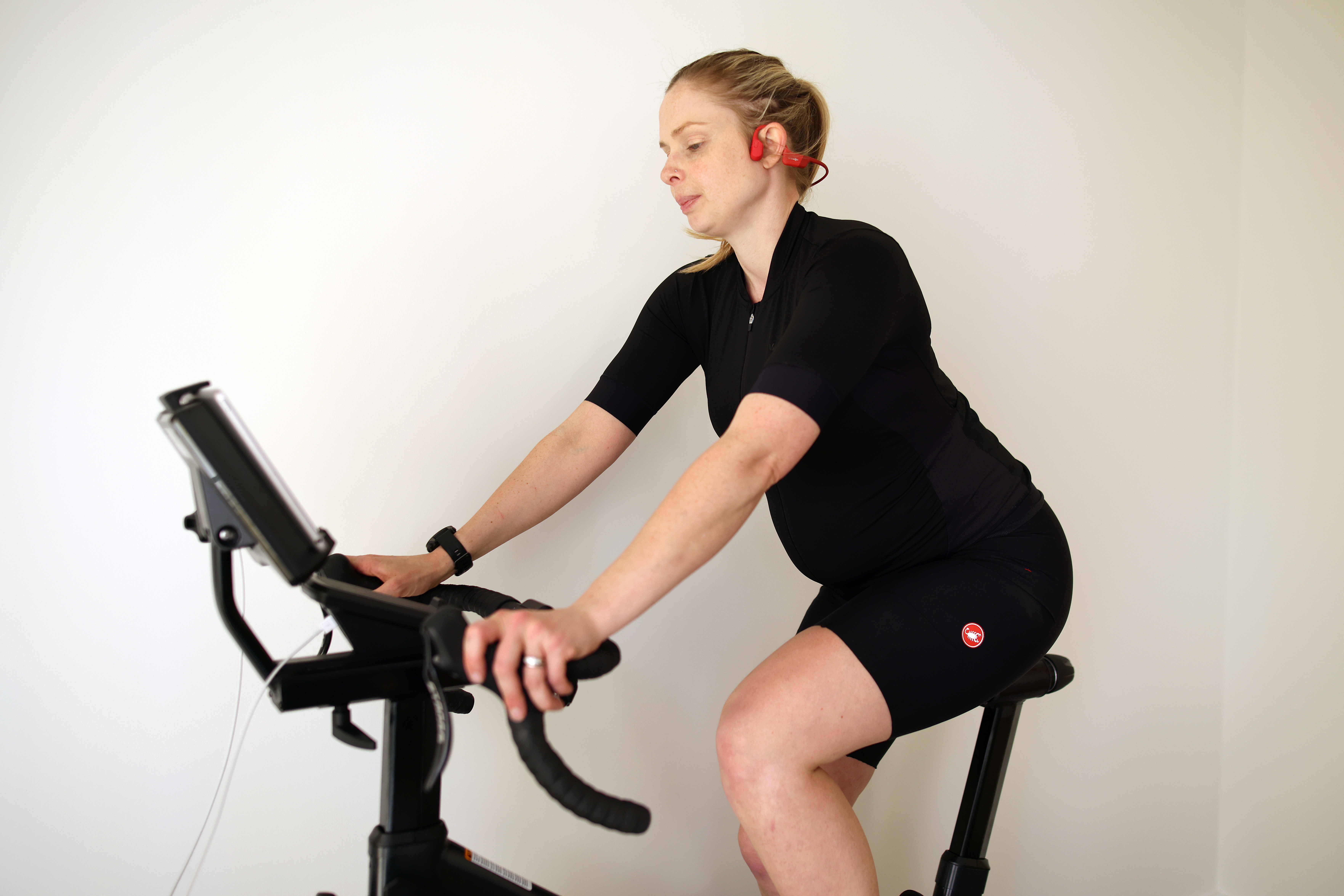
Getting on with a Stages SB20 bike session, at 27 weeks pregnant
I tested the Stages SB20 throughout my first pregnancy, making my review criteria a little different when compared with my normal approach. Since one of the draws of choosing a dedicated exercise bike over one of the best turbo trainers is the option for it to be used by all the family, hopefully, my perspective can add a little diversity to the traditional cycling journalism melee.
Usually a performance-focused road racer, during this testing period, I was more concerned with adjustability and reliability. Trust me - no brand wants its equipment to be asking a 38-week-pregnant-mum-to-be to faff around with apps and zero offsets whilst trying to squeeze a session in before work, on the last week before maternity leave begins, when it's 28 degrees outside.
What's perhaps most notable is that, over the course of around nine months, I only ever encountered one instance of the bike being the root cause of frustration. This took place around mid-way through the testing period when (for whatever reason), the SB20 failed to produce any resistance. I solved this by logging into the app, and completing a zero-offset, this took about five minutes (look, I'm easily frustrated - but that's what you want in a product tester).
Aside from that, the power numbers always appeared within range of expectation. Hooking up both my Garmin Rally pedals alongside the Stages power readings for a quick direct comparison, the numbers (low as they were, I was 38 weeks pregnant at time of running this test!) showed minimal deviation. So, whilst the +/-1.5% accuracy does cast a bit of shade on the bike, it didn't appear to affect my day-to-day use - this would only become a concern if you're extremely performance-focused, and likely to become mentally scarred by producing 1 watt less, on any given day, for the same interval.

Right click on the image and 'open in new tab' to view in more detail

Most of my riding on the Stages indoor bike involved the use of either a Zwift 'Baby on Board' session, a The Sufferfest video within Wahoo-X, or just riding around Zwift's virtual haven. In pretty much every instance, I rode with the Erg mode on; this is actually a departure from my usual approach. When training in earnest for a race season, I tend to complete coach set sessions, riding without ERG and aiming to sit within a power band.
Whilst it's quite hard to prove - or, to be honest, be absolutely confident in my assertions - without having two units, side-by-side, I did notice that the ERG mode sometimes took a while to ramp up to the desired power output, during short intervals. In 10-second bursts, I'd rarely reach the suggested output. On the counterpoint, the bike didn't have quite the same tendency to cause me to grind to a halt via over-egging the resistance, as some do. In my current mindset of "training for exercise, not performance", this worked well - but it might be an issue were I in a more competitive place in my training journey.
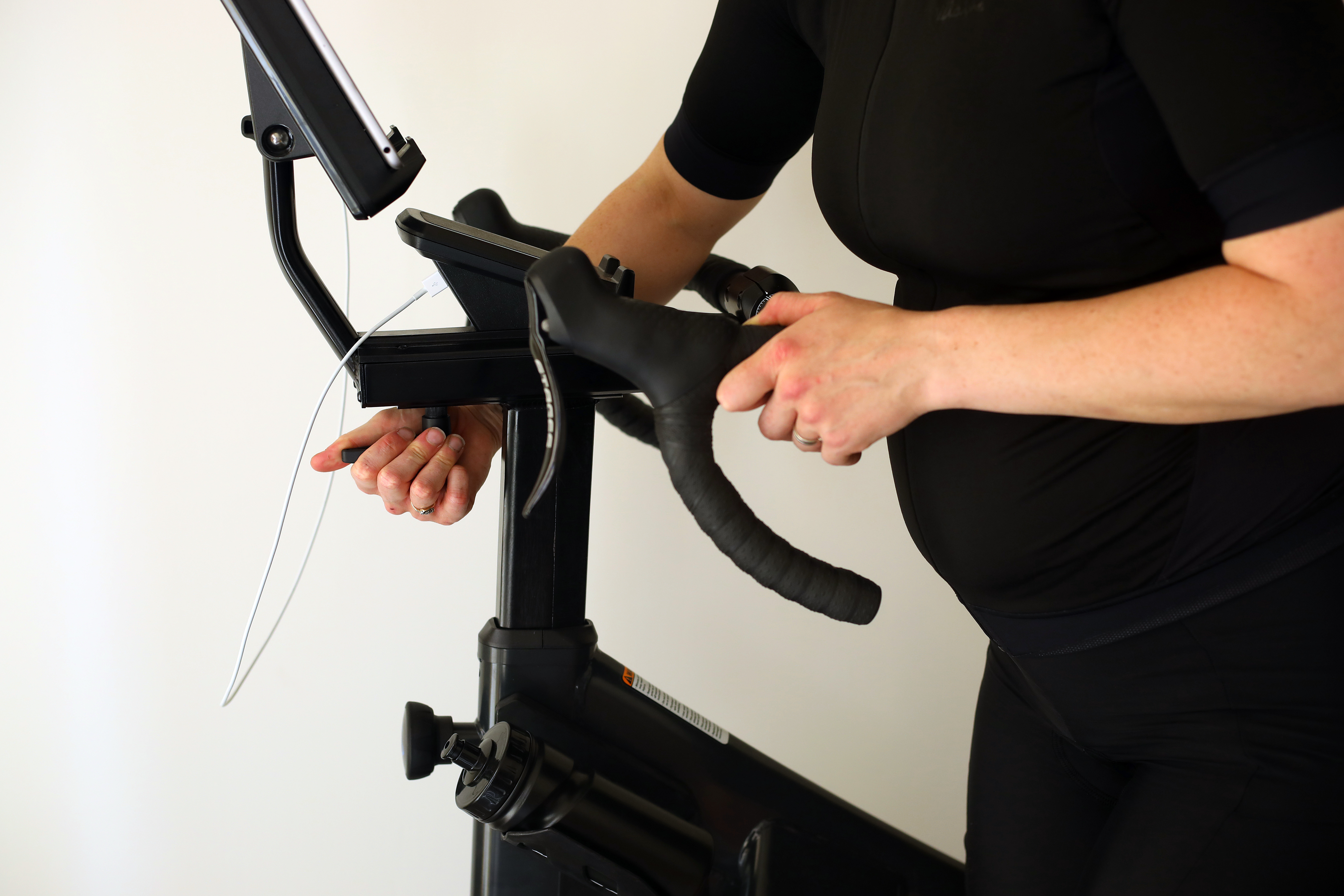
Manipulating the bike to fit my changing shape was easy, and I'd say that it's likely I've made more adjustments than most would expect to. I never encountered any slipping or roughness, and all of the levers operated smoothly and firmly held their components in place. I found that making adjustments was much smoother when compared with the Wahoo Kickr Bike, where each change involved a series of juddering movements in order to achieve the correct position (you'll notice I listed this as a con in the Wahoo Kickr Bike review).
If I were to be extremely picky - pedantic, even - I would point out that the bike is clearly designed to be ridden in a more racey position than I had it towards the end of my test period, meaning that in order to pick up my water bottle from the holder I had to bend quite far.
On a positive note, having USB ports to hand was extremely useful, on the several incidents where I logged on for a session only to find I had minimal charge left in my iPad.
There is absolutely no doubting that the Stages SB20 bike is robust. It's lived both in my utility (next to the washing machine), and in my kitchen. I've banged it about the house moving it between those two rooms, and it still looks exactly as new. Obviously, at 62.5kg, I wasn't sprinting hard enough to cause it to rock or move, and I'd be amazed if even a pro track rider encountered problems to this effect. There are also no obvious weak points for sweat ingress, which is one of the biggest killers of bikes of this nature.
Stages SB20: value and conclusions
The RRP on the Stages SB20 is £2800/$3149. You'd actually be hard-pressed to find it at this price. In the UK, distributors Saddleback have it on sale for £1,699 (£1,899 with set up).
Whilst it's hard to judge absolutely, the ERG mode doesn't appear to be quite as sharp when compared with competitors. The claimed power accuracy is also lower - but that didn't play out in practice. However, these factors might be a turn-off for racers after the absolute in performance when racing on Zwift.
However, in terms of durability and liveability, Stages does seem to have it nailed. The bike is extremely heavy and robust. As long as you can get it to the desired position in your home, that's a plus. It's also got a great user console system, with the best screen set up I've seen in an exercise bike, and the benefit of charging ports.
For my purposes, and for those of any user looking for a reliable machine they can hop onto and churn away on daily, the Stages SB20 comes highly recommended.

Thank you for reading 20 articles this month* Join now for unlimited access
Enjoy your first month for just £1 / $1 / €1
*Read 5 free articles per month without a subscription

Join now for unlimited access
Try first month for just £1 / $1 / €1
Get The Leadout Newsletter
The latest race content, interviews, features, reviews and expert buying guides, direct to your inbox!
Michelle Arthurs-Brennan the Editor of Cycling Weekly website. An NCTJ qualified traditional journalist by trade, Michelle began her career working for local newspapers. She's worked within the cycling industry since 2012, and joined the Cycling Weekly team in 2017, having previously been Editor at Total Women's Cycling. Prior to welcoming her first daughter in 2022, Michelle raced on the road, track, and in time trials, and still rides as much as she can - albeit a fair proportion indoors, for now.
Michelle is on maternity leave from April 2025 until spring 2026.
-
 'I'll take a top 10, that's alright in the end' - Fred Wright finishes best of British at Paris-Roubaix
'I'll take a top 10, that's alright in the end' - Fred Wright finishes best of British at Paris-RoubaixBahrain-Victorious rider came back from a mechanical on the Arenberg to place ninth
By Adam Becket Published
-
 'This is the furthest ride I've actually ever done' - Matthew Brennan lights up Paris-Roubaix at 19 years old
'This is the furthest ride I've actually ever done' - Matthew Brennan lights up Paris-Roubaix at 19 years oldThe day's youngest rider reflects on 'killer' Monument debut
By Tom Davidson Published
-
 'One of the hardest races I've ever done in my life' - Tadej Pogačar finishes runner-up on Paris-Roubaix debut after crash
'One of the hardest races I've ever done in my life' - Tadej Pogačar finishes runner-up on Paris-Roubaix debut after crashWorld champion reacts to 'extremely hard' battle with Mathieu van der Poel
By Tom Davidson Published